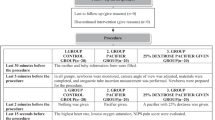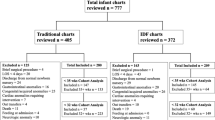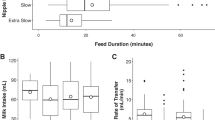Abstract
OBJECTIVE: To compare the safety of cupfeeding, an alternative feeding method, to bottlefeeding, the current standard of artificial feeding in the United States, in preterm infants whose mothers intend to breastfeed.
STUDY DESIGN: In a prospective, randomized crossover study, 56 infants ≤34 weeks at birth, whose mothers indicated a desire to breastfeed, were studied. Skin-to-skin care and attempts at breast were encouraged frequently when babies were physiologically stable. When infants were ≥34 weeks' corrected gestational age, the order of the first two non–breast oral feedings was randomized by coin toss to one cupfeeding and one bottlefeeding. Trained Neonatal Intensive Care Unit nurses provided the feedings. Heart rate, respiratory rate, and oxygen saturation were recorded at 1-minute intervals for 10 minutes before and during the feeding. Volume taken, time required to complete the feed, and any apnea, bradycardia, choking, or spitting episodes were recorded.
RESULTS: Heart rate ( p<0.0001) and respiratory rate ( p<0.0001) increased and oxygen saturation decreased ( p=0.0002) during both cup and bottlefeedings compared to pre-feeding baselines. The amount of change in these three parameters from baseline to feeding period was similar for both feeding methods. The fraction of O 2 saturation <90% during baseline compared to the study period was different between these two feeding methods ( p=0.02). There was a 10-fold increase in desaturations <90% during bottlefeeds compared to no change during cupfeeds. When comparing cupfeeding periods to bottlefeeding periods, heart rates were higher ( p=0.009) and oxygen saturations lower ( p=0.02) during bottlefeeds. There were no differences between methods in respiratory rate, choking, spitting or apnea, and bradycardia. Volumes taken were lower ( p=0.001) and duration of feeds longer ( p=0.002) during cupfeedings.
CONCLUSION: During cupfeedings, premature infants are more physiologically stable, with lower heart rates, higher oxygen saturations, and less desaturations, than during bottlefeedings. However, cupfed infants took less volume, over more time, than bottlefed for these initial feedings. Based on better physiologic stability and no difference in untoward effects, cupfeeding is at least as safe, if not safer, than bottlefeeding in this population. This study supports the use of cupfeeding as a safe alternative feeding method for premature infants learning to breastfeed.
This is a preview of subscription content, access via your institution
Access options
Subscribe to this journal
Receive 12 print issues and online access
$259.00 per year
only $21.58 per issue
Buy this article
- Purchase on Springer Link
- Instant access to full article PDF
Prices may be subject to local taxes which are calculated during checkout
Similar content being viewed by others
References
American Academy of Pediatrics, Work Group on Breastfeeding Breastfeeding and the use of human milk Pediatrics 1997 100 1035–9
Schanler RJ, Hurst NM, Lau C The use of human milk and breastfeeding in premature infants Clin Perinatol 1999 26 379–98
Lucas A AIDS and milk bank closures Lancet 1987 1 1092–3
Uraizee F, Gross S Improved feeding tolerance and reduced incidence of sepsis in sick very-low-birth-weight infants fed maternal milk Pediatr Res 1989 25 298A
Cavell B Gastric emptying in infants fed human milk or infant formula Acta Paediatr Scand 1981 70 639–41
Schanler R, Shulman R, Lau C Feeding strategies for premature infants: beneficial outcomes of feeding fortified human milk versus preterm formula Pediatrics 1999 103 1150–7
Narayanan I, Prakash K, Gujral V The value of human milk in the prevention of infection in the high-risk low-birth-weight infant J Pediatr 1981 99 496–8
Narayanan I, Prakash K, Murthy NS, Gujral VV Randomized controlled trial of effect of raw and holder pasteurized human milk and of formula supplements on incidence of neonatal infection Lancet 1984 2 1111–3
Narayanan I, Prakash K, Bala S, Verma RK Partial supplementation with expressed breastmilk for prevention of infection in low-birth-weight infants Lancet 1980 2 561–3
Schanler RJ Suitability of human milk for the low-birth-weight infant Clin Perinatol 1995 22 207–22
Lucas A, Cole T Breast milk and neonatal necrotizing enterocolitis Lancet 1990 336 1519–23
Covert RF, Barman N, Domanico RS, Singh JK Prior enteral nutrition with human milk protects against intestinal perforation in infants who develop necrotizing enterocolitis Pediatr Res 1995 37 305A
Yu VYH, Jamieson J, Bajuk B Breast milk feeding in very-low-birth-weight infants Aust Paediatr J 1981 17 186–90
Lucas A, Morley R, Cole TJ, Lister G, Leeson-Payne C Breastmilk and subsequent intelligence quotient in children born preterm Lancet 1992 339 261–4
Hagan R, French N, Evans S, et al Breastfeeding, distractability and IQ in very preterm infants Pediatr Res 1996 39 266A
Hylander MA, Strobino DM, Dhanireddy R Human milk feedings and retinopathy of prematurity (ROP) among very-low-birth-weight (VLBW) infants Pediatr Res 1995 37 214A
Uauy R, Birch D, Birch E, Tyson JE, Hoffman D Effect of dietary omega-3 fatty acids on retinal function of very-low-birth-weight neonates Pediatr Res 1990 28 485–92
Birch E, Birch D, Hoffman D, Hale L, Everett M, Uauy R Breastfeeding and optimal visual development J Pediatr Ophthalmol Strabismus 1993 30 33–8
Carlson SE, Werkman SH, Rhodes PG, Tolley EA Visual acuity development in healthy preterm infants: effects of marine oil supplementation Am J Clin Nutr 1993 58 35–42
Newman J Breastfeeding problems associated with the early introduction of bottles and pacifiers J Hum Lactation 1990 6 59–63
Barros, FC, Victora CG, Semer TC, Filho ST, Tomasi E, Weiderpass E Use of pacifiers is associated with decreased breastfeeding duration Pediatrics 1995 95 497–9
Righard L Are breastfeeding problems related to incorrect breastfeeding technique and the use of bottles and pacifiers? Birth 1998 25 40–4
Nyquist KH, Ewald U Infant and maternal factors in the development of breastfeeding behaviour and breastfeeding outcome in preterm infants Acta Paediatr 1999 88 1194–203
Fisher C Breastfeeding, a midwife's view J Matern Child Health 1981 6:52–7
Woolridge MW The anatomy of infant sucking Midwifery 1986 2 164–71
Ardran GM, Kemp FH, Lind JA Cineradiographic study of bottlefeeding Br J Radiol 1958 31 11–22
Adran GM, Kemp FH, Lind JA Cineradiographic study of breastfeeding Br J Radiol 1958 31 156–62
Righard L, Alade MO Sucking technique and its effect on success of breastfeeding Birth 1992 19 185–9
Hill PD, Ledbetter RJ, Kavanaugh KL Breastfeeding patterns of low-birth-weight infants at hospital discharge JOGNN 1997 26 189–97
Kaufman KJ, Hall LA Influences of the social network on choice and duration of breastfeeding in mothers of preterm infants Res Nurs Health 1989 12 149–59
Lefebvre F, Ducharme M Incidence and duration of lactation and lactational performance among mothers of low-birth-weight and term infants Can Med Assoc J 1989 140 1159–64
Meier PP, Engstom JL, Mangurten HH, Estrada E, Zimmerman B, Kopparhi R Breastfeeding support services in the neonatal intensive care unit JOGNN 1993 22 338–47
Furman L, Minich NM, Hack M Breastfeeding of very-low-birth-weight infants J Hum Lactation 1998 14 29–34
Jaeger MC, Lawson M, Filteau S The impact of prematurity and neonatal illness on the decision to breastfeed J Adv Nurs 1997 25 729–37
Yip E, Lee J, Sheehy Y Breastfeeding in neonatal intensive care J Paediatr Child Health 1996 32 296–8
Ryan A The resurgence of breastfeeding in the United States Pediatrics 1997 99 e12
Armstrong HC Breastfeeding low-birth-weight babies: advances in Kenya J Hum Lactation 1987 3 34–7
Muhudhia SO, Musoke RN Postnatal weight gain of exclusively breastfed preterm African infants J Trop Pediatr 1989 35 241–4
Musoke RN Breastfeeding promotion: feeding the low-birth-weight infant Int J Gynecol Obstet 1990 31 (Suppl 1) 57–9
Lang S, Lawrence CJ, L'E Orme R Cupfeeding: an alternative method of infant feeding Arch Dis Child 1994 71 365–9
Jones E Breastfeeding in the preterm infant Mod Midwife 1994 4 22–6
Nyquist KH, Strandell E A cupfeeding protocol for neonates: evaluation of nurses' and parents' use of two cups J Neonat Nurs 1999 5 6–11
Blaymore Bier J, Ferguson A, Anderson L, et al Breastfeeding of very-low-birth-weight infants J Pediatr 1993 123 773–8
Blaymore Bier J, Ferguson A, Morales Y, Liebling J, Oh W, Vohr B Breastfeeding infants who were extremely low birth weight Pediatrics 1997 100 e3
Meier P, Anderson G Responses of small preterm infants to bottle- and breastfeeding MCN 1987 12 97–105
Meier P Bottle- and breastfeeding: effects on transcutaneous oxygen pressure and temperature in preterm infants Nurs Res 1988 37 36–41
Meier P Suck–breath patterning during bottle and breastfeeding for preterm infants In: David TJ, ed. Major Controversies in Infant Nutrition. International Congress and Symposium Series 215 London: Royal Society of Medicine Press 1996 pp. 9–20
Lang S Cupfeeding: an alternative method Midwives' Chronicle 1994 107 171–6
Fredeen RC Cupfeeding of newborn infants Pediatrics 1948 2 544–8
Howard CR, de Blieck EA, ten Hoopen CB, Howard FM, Lanphear BP, Lawrence RA Physiologic stability of newborns during cup- and bottlefeeding Pediatrics 1999 104 1204–7
Als H, Gilkerson L Developmentally supportive care in the neonatal intensive care unit Zero Three 1995 15 1–10
Charpak N, Ruiz-Pelaez JG, Figueroa ZD, Charpak Y Kangaroo mother versus traditional care for newborn infants less than or equal to 2000 grams: a randomized, controlled trial Pediatrics 1997 100 682–8
Anderson GC Current knowledge about skin-to-skin (Kangaroo) care for preterm infants J Perinatol 1991 11 216–26
Hurst N, Valentine C, Renfro L, Burns P, Ferlic L Skin-to-skin holding in the neonatal intensive care influences maternal milk volume J Perinatol 1997 17 213–7
Blaymore Bier J, Ferguson AE, Morales Y, Liebling JA, Archer D, Oh W, Vohr BR Comparison of skin-to-skin contact with standard contact in low-birth-weight infants who are breastfed Arch Pediatr Adolesc Med 1996 150 1265–9
Acknowledgements
We thank Susan Zaremba for help with data and chart review Linda Kaczmarczyk, research librarian, Mark Bamberger for his invaluable assistance with data management, and Victor Herson for his thoughtful review of this manuscript. We are indebted to the staff of the NICU for their patience and assistance in carrying out this study, and especially to the study nurses whose devotion to supporting breastfeeding mothers enabled us to introduce cupfeeding to our NICU.
Author information
Authors and Affiliations
Rights and permissions
About this article
Cite this article
Marinelli, K., Burke, G. & Dodd, V. A Comparison of the Safety of Cupfeedings and Bottlefeedings in Premature Infants Whose Mothers Intend to Breastfeed. J Perinatol 21, 350–355 (2001). https://doi.org/10.1038/sj.jp.7210539
Published:
Issue Date:
DOI: https://doi.org/10.1038/sj.jp.7210539
This article is cited by
-
Non-Pharmacological and Non-Surgical Feeding Interventions for Hospitalized Infants with Pediatric Feeding Disorder: A Scoping Review
Dysphagia (2023)
-
Effect of cup, syringe, and finger feeding on time of oral feeding of preterm neonate’s: a randomized controlled clinical trial
Journal of Health, Population and Nutrition (2022)
-
A Comparative Study of Two Infant Feeding Tools: The Nifty Cup and The Paladai
The Indian Journal of Pediatrics (2020)
-
Cup Feeding as a Supplemental, Alternative Feeding Method for Preterm Breastfed Infants: An Integrative Review
Maternal and Child Health Journal (2018)
-
Feeding Neonates by Cup: A Systematic Review of the Literature
Maternal and Child Health Journal (2016)



